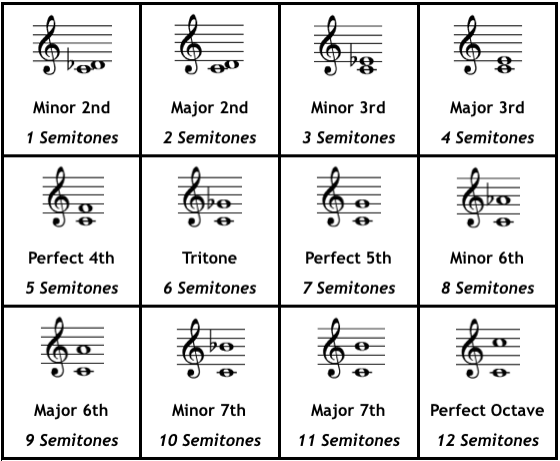
Musical intervals are the fundamental elements of music, acting as the building blocks for everything from simple melodies to complex harmonies. An interval is the distance between two pitches, and grasping this concept is crucial for anyone who wishes to deepen their understanding of music theory. Whether you are a budding musician just starting your journey or a seasoned composer looking to refine your skills, mastering intervals can significantly enhance your musical creativity and technical proficiency.
In this blog, we’ll delve into the concept of musical intervals, breaking down their types, explaining how to identify them, and highlighting their critical role in music theory. By the end of this article, you’ll have a solid foundation in musical intervals, enabling you to create more compelling music and improve your ability to interpret and perform various pieces. Whether you’re composing new music, playing an instrument, or simply trying to understand the music you love better, a thorough understanding of musical intervals is invaluable. Let’s get started!
What are Intervals
An interval refers to the distance between two notes. Intervals can be played harmonically, where two notes sound simultaneously, or melodically, where they sound in sequence. Understanding intervals helps musicians create harmonies, melodies, and understanding the structure of scales and chords.
Types of Intervals
Intervals can be categorized into diatonic and compound intervals:
Diatonic intervals
Simple intervals are those that span one octave or less. Here are some examples:
Unison: The same note played together (e.g., C and C).
Second: A distance of two notes (e.g., C to D).
Third: A distance of three notes (e.g., C to E).
Fourth: A distance of four notes (e.g., C to F).
Fifth: A distance of five notes (e.g., C to G).
Sixth: A distance of six notes (e.g., C to A).
Seventh: A distance of seven notes (e.g., C to B).
Octave: The same note an octave apart (e.g., C to the next C).
Compound Intervals
Compound intervals span more than one octave.
For example:
Ninth: An octave plus a second (e.g., C to D an octave higher).
Tenth: An octave plus a third (e.g., C to E an octave higher).
Interval pronounced
Intervals also have different qualities that affect their sound and feel
Perfect: Unison, fourth, fifth, and octave (e.g., C to G is a perfect fifth).
Major: Seconds, thirds, sixths, and sevenths when larger (e.g., C to E is a major third).
Minor: Seconds, thirds, sixths, and sevenths when smaller (e.g., C to Eb is a minor third).
Augmented: Intervals that are one half-step larger than perfect or major intervals (e.g., C to G# is an augmented fifth).
Diminished: Intervals that are one half-step smaller than perfect or minor intervals (e.g., C to Gb is a diminished fifth).

How to Identify Intervals
Identifying intervals can be practiced through both ear training and sight-reading. Mastering these skills will enhance your musical ear and improve your ability to read and perform music accurately. Here are some detailed tips on how to identify intervals effectively
By Ear
Use Familiar Melodies: Associating intervals with well-known songs can make them easier to identify.
For instance: a perfect fifth can be recognized by the opening notes of “Twinkle, Twinkle, Little Star” (C to G).
Interval Training Apps: There are various apps and online tools designed to help musicians practice interval recognition. These tools often play intervals at random, allowing you to test your ability to identify them by ear.
Intervals also have different qualities that affect their sound and feel
Perfect: Unison, fourth, fifth, and octave (e.g., C to G is a perfect fifth).
Major: Seconds, thirds, sixths, and sevenths when larger (e.g., C to E is a major third).
Minor: Seconds, thirds, sixths, and sevenths when smaller (e.g., C to Eb is a minor third).
Augmented: Intervals that are one half-step larger than perfect or major intervals (e.g., C to G# is an augmented fifth).
Diminished: Intervals that are one half-step smaller than perfect or minor intervals (e.g., C to Gb is a diminished fifth).
Singing Intervals: Practice singing intervals up and down the scale. Start with a known reference note and sing the interval you are trying to learn. This helps internalize the sound of the interval.
Interval Drills: Regularly practice interval drills where you listen to and identify random intervals played on a piano or another instrument. This can be done with a partner or using recorded drills.
By Sight
Learning to recognize intervals on sheet music is an essential skill for any musician, aiding in sight-reading and understanding musical structure. Here are some strategies to improve your visual identification of intervals:
Counting Steps: When looking at sheet music, count the number of lines and spaces between the two notes. Each line and space represent a step in the scale. For example, from C to E spans three letter names (C-D-E), which makes it a third.
Interval Cheat Sheets: Create or download a cheat sheet that shows the visual patterns of various intervals on the staff. Regularly reviewing this sheet can help reinforce your ability to recognize intervals quickly.
Practice with Music Pieces: Take a piece of sheet music and identify all the intervals between the notes. Start with simple melodies and gradually move to more complex pieces as your skills improve.
By consistently practicing these techniques, you can significantly improve your ability to identify musical intervals both by ear and sight. This dual approach will enhance your overall musicianship, making you a more versatile and skilled performer and composer.
Importance of Intervals in Music Theory
Intervals are foundational in music theory, serving as the building blocks for scales, chords, and harmonies. Understanding intervals is essential for anyone looking to grasp the structure and function of music.
Scales:
Scales are sequences of notes ordered by pitch. A major scale, for example, is built from a specific sequence of whole steps (tones) and half steps (semitones). The pattern for a major scale is whole, whole, half, whole, whole, whole, half. This interval pattern creates the familiar sound of the major scale. For instance, the C major scale (C-D-E-F-G-A-B-C) follows this pattern, with the intervals between the notes defining the scale’s character.
Chords:
Chords are combinations of three or more notes played simultaneously. They are formed by stacking intervals on top of each other. A basic triad, like a C major chord, consists of a root note (C), a major third (E), and a perfect fifth (G). Each interval within the chord contributes to its overall sound and function within a piece of music. The understanding of how these intervals stack and relate to each other is crucial for chord construction and progression.
Harmony:
Harmony involves the combination of different musical notes played or sung simultaneously. Understanding intervals is crucial for creating harmonic progressions, which are sequences of chords that provide the backbone for most musical pieces. Intervals help define the relationship between chords and notes, allowing musicians to craft progressions that are pleasing to the ear and supportive of the melody. For example, knowing that a dominant seventh chord resolves naturally to a tonic chord relies on understanding the intervals within these chords and their functions within a key.
By mastering intervals, musicians can enhance their ability to compose, arrange, and perform music that is structurally sound and harmonically rich. Whether creating a simple melody or a complex symphony, the role of intervals is indispensable in shaping the music we hear and play.
